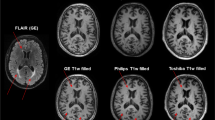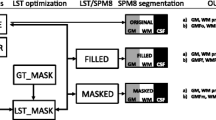Abstract
Purpose
Brain volume estimates from magnetic resonance images (MRIs) are of great interest in multiple sclerosis, and several automated tools have been developed for this purpose. The goal of this study was to assess the agreement between two tools, NeuroQuant® (NQ) and FMRIB’s Integrated Registration Segmentation Tool (FIRST), for estimating overall and regional brain volume in a cohort of patients with a clinically isolated syndrome (CIS). In addition, white matter lesion volume was estimated with NQ and the Lesion Segmentation Toolbox (LST).
Methods
One hundred fifteen CIS patients were analysed. Structural images were acquired on a 3.0-T system. The volume agreement between methods (by estimation of the intraclass correlation coefficient) was calculated for the right and left thalamus, caudate, putamen, pallidum, hippocampus, and amygdala, as well as for the total intracranial volume and white matter lesion volume.
Results
In general, the estimated volumes were larger by NQ than FIRST, except for the pallidum. Agreement was low (ICC < 0.40) for the smaller structures (amygdala and pallidum) and fair to good (ICC > 0.40) for the remaining ones. Agreement was fair for lesion volume (ICC = 0.61), with NQ estimates lower than LST.
Conclusions
Agreement between NQ and FIRST brain volume estimates depends on the size of the structure of interest, with larger volumes achieving better agreement. In addition, concordance between the two tools does seem to be dependent on the presence of brain lesions.




Similar content being viewed by others
References
Tintore M, Rovira À, Río J, Otero-Romero S, Arrambide G, Tur C, Comabella M, Nos C, Arévalo MJ, Negrotto L, Galán I, Vidal-Jordana A, Castilló J, Palavra F, Simon E, Mitjana R, Auger C, Sastre-Garriga J, Montalban X. Defining high, medium and low impact prognostic factors for developing multiple sclerosis. Brain 2015;138(Pt 7):1863–1874
Hauser SL, Oksenberg JR (2006) The neurobiology of multiple sclerosis: genes, inflammation, and neurodegeneration. Neuron 52(1):61–76
Sastre-Garriga J, Pareto D, Rovira À (2017) Brain atrophy in multiple sclerosis: clinical relevance and technical aspects. Neuroimaging Clin N Am 27(2):289–300
Ashburner J, Friston KJ (2000) Voxel-based morphometry—the methods. Neuroimage. 11(6 Pt 1):805–821
Smith SM, Zhang Y, Jenkinson M, Chen J, Matthews PM, Federico A, De Stefano N (2002) Accurate, robust, and automated longitudinal and cross-sectional brain change analysis. Neuroimage 17(1):479–489
Patenaude B, Smith SM, Kennedy D, Jenkinson MA (2011) Bayesian model of shape and appearance for subcortical brain. NeuroImage 56(3):907–922
Schmidt P, Gaser C, Arsic M, Buck D, Förschler A, Berthele A, Hoshi M, Ilg R, Schmid VJ, Zimmer C, Hemmer B, Mühlau M (2012) An automated tool for detection of FLAIR-hyperintense white-matter lesions in multiple sclerosis. NeuroImage 59:3774–3783
Pelletier D, Garrison K, Henry R (2004) Measurement of whole-brain atrophy in multiple sclerosis. J Neuroimaging 14(3 Suppl):11S–19S
Bermel RA, Bakshi R (2006) The measurement and clinical relevance of brain atrophy in multiple sclerosis. Lancet Neurol 5(2):158–170
Rocca MA, Battaglini M, Benedict RH, De Stefano N, Geurts JJ, Henry RG, Horsfield MA, Jenkinson M, Pagani E, Filippi M (2017) Brain MRI atrophy quantification in MS: From methods to clinical application. Neurology 88(4):403–413
Ochs AL, Ross DE, Zannoni MD, Abildskov TJ, Bigler ED (2015) Alzheimer’s disease neuroimaging initiative. Comparison of automated brain volume measures obtained with NeuroQuant and FreeSurfer. J Neuroimaging 25(5):721–727
Wang C, Beadnall HN, Hatton SN, Bader G, Tomic D, Silva DG, Barnett MH (2016) Automated brain volumetrics in multiple sclerosis: a step closer to clinical application. J Neurol Neurosurg Psychiatry 87(7):754–757
Swanton JK, Rovira A, Tintore M, Altmann DR, Barkhof F, Filippi M, Huerga E, Miszkiel KA, Plant GT, Polman C, Rovaris M, Thompson AJ, Montalban X, Miller DH (2007) MRI criteria for multiple sclerosis in patients presenting with clinically isolated syndromes: a multicentre retrospective study. Lancet Neurol 6(8):677–686
Pareto D, Sastre-Garriga J, Aymerich FX, Auger C, Tintoré M, Montalban X, Rovira A (2016) Lesion filling effect in regional brain volume estimations. A study in multiple sclerosis patients with low lesion load. Neuroradiology 58(5):467–474
Shrout PE, Fleiss JL (1979) Intraclass correlations: uses in assessing rater reliability. Psychol Bull 86:420–428
Gatidis S, Heber SD, Storz C, Bamberg F (2017) Population-based imaging biobanks as source of big data. Radiol Med 122(6):430–436
Acknowledgements
We thank the Statistics and Bioinformatics Unit at the Vall d’Hebron Research Institute for their statistical assessment and C. Cavallo for English writing support.
Funding
This study was partially supported by Novartis Farmacéutica S.A., Barcelona (Spain), the “Red Española de Esclerosis Múltiple (REEM)” (RD07/0060; RD12/0032), which is sponsored by the Fondo de Investigación Sanitaria (FIS), the Instituto de Salud Carlos III, the Ministry of Economy and Competitiveness in Spain and the “Ajuts per donar Suport als Grups de Recerca de Catalunya (2009 SGR 0793)”, which is sponsored by the “Agència de Gestió d’Ajuts Universitaris i de Recerca” (AGAUR) of the Generalitat de Catalunya in Spain.
Author information
Authors and Affiliations
Corresponding author
Ethics declarations
Conflict of interest
DP has received speaking honoraria from Sanofi-Genzyme. JS-G has received travel and accommodation grants from Merck, Novartis, TEVA, Celgene, Roche, Sanofi and Excemed. MA has been sponsored by Novartis Farmacéutica S.A., Barcelona (Spain). CA has received speaking honoraria from Novartis, Stendhal and Biogen. MT has received speaking honoraria and travel expenses from Amirall, Bayer, Biogen Idec, Genzyme, Merck Serono, Novartis, Sanofi-Aventis, Roche and Teva. XM has received speaking honoraria and travel expenses, and has been a steering committee member of clinical trials or participated in advisory boards of clinical trials for Actelion, Almirall, Bayer, Biogen, Celgene, Hoffmann-La Roche, Merck, Novartis, Oryzon Genomics, Sanofi-Genzyme and Teva Pharmaceutical. AR has served/s on scientific advisory boards for Novartis, Sanofi-Genzyme, Icometrix, and OLEA Medical, and has received speaker honoraria from Bayer, Sanofi-Genzyme, Bracco, Merck-Serono, Teva Pharmaceutical Industries Ltd., Novartis, Roche and Biogen Idec.
Ethical approval
All procedures performed in studies involving human participants were in accordance with the ethical standards of the institutional and/or national research committee and with the 1964 Helsinki declaration and its later amendments or comparable ethical standards.
Informed consent
Informed consent was obtained from all individual participants included in the study.
Additional information
Publisher’s note
Springer Nature remains neutral with regard to jurisdictional claims in published maps and institutional affiliations.
Rights and permissions
About this article
Cite this article
Pareto, D., Sastre-Garriga, J., Alberich, M. et al. Brain regional volume estimations with NeuroQuant and FIRST: a study in patients with a clinically isolated syndrome. Neuroradiology 61, 667–674 (2019). https://doi.org/10.1007/s00234-019-02191-3
Received:
Accepted:
Published:
Issue Date:
DOI: https://doi.org/10.1007/s00234-019-02191-3




